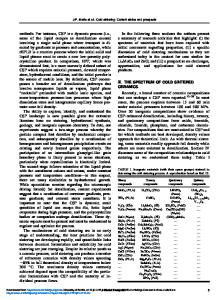Whisker Growth in Sn Coatings: A Review of Current Status and Future Prospects
- PDF / 11,343,822 Bytes
- 32 Pages / 593.972 x 792 pts Page_size
- 0 Downloads / 472 Views
https://doi.org/10.1007/s11664-020-08440-z Ó 2020 The Minerals, Metals & Materials Society
TMS2020 MICROELECTRONIC PACKAGING, INTERCONNECT, AND PB-FREE SOLDER
Whisker Growth in Sn Coatings: A Review of Current Status and Future Prospects PIYUSH JAGTAP
1,3
and PRAVEEN KUMAR2,4
1.—School of Engineering, Brown University, Providence, RI 02912, USA. 2.—Department of Materials Engineering, Indian Institute of Science, Bangalore 560012, India. 3.—e-mail: [email protected]. 4.—e-mail: [email protected]
Whiskering is a spontaneous filamentary growth of material, and it is a major long-term reliability issue affecting microelectronic packages comprising Sn plating and Sn-rich solders. In particular, whisker growth out of Sn-plated surfaces has been studied extensively in recent years due to the advent of next-generation, environment-friendly, Pb-free microelectronic packaging. Here, we review this scientifically challenging and technologically important problem, especially in the light of relatively new insights gained in the recent past, intending to provide a quick overview of the important results and stimulating future studies. In particular, we discuss the mechanisms of whisker growth by critically examining the roles of stress and its regeneration, oxide layer, diffusion conduits, and crystal anisotropy in creating conditions conducive for whiskering. We also discuss the recent proposals for effectively mitigating whisker growth in Sn coatings. Finally, an outlook is provided, with details of important unresolved issues related to whisker growth. Key words: Tin whiskering, stress regeneration, diffusivity, oxide layer, whiskering mechanism, whisker mitigation
INTRODUCTION Whiskers are single-crystalline, high-purity filaments with a high aspect ratio that often grow spontaneously from plated surfaces of Sn and a few other low-melting-temperature metals, such as Cd, Zn, Al, and Ag.1 Although whisker growth from metals has a well-documented history of only 70 years, a recent report2 cites the earliest record of whisker formation back in the sixteenth century. Ercker, who was a practical metallurgist and superintendent of mines to Emperor Rudolf II of Bohemia, first reported silver hairs in his Treatise on Ores and Assaying.3 He observed that the silver hairs grew
(Received April 27, 2020; accepted August 20, 2020)
when silver objects or coins were slightly cut or scratched and then held over a charcoal fire. Incidentally, the whisker growth phenomenon never gained attention until World War II, when electrical communication systems started to report failures due to short-circuiting caused by Cd whiskers. Thereafter, the first public report on whiskering was published by Cobb4 summarizing Cd whisker-related failures in radio instruments used during World War II. Interestingly, the majority of recent studies have been focused on whisker growth in Sn-plated surfaces due to its widespread use in electrical and electronic components. The growth of whiskers from Sn-plated surfaces continues to be responsible for fa
Data Loading...











